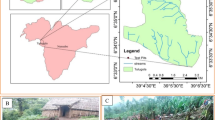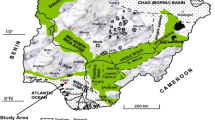Abstract
Landslides have resulted in large numbers of casualties and huge economic losses in the hilly and mountainous areas of the Ethiopian highlands. Adishu (Adi-Quchi and Quilet villages in particular) is one of the areas most highly affected by rainfall-driven landslides. Field investigations of this area have revealed displacement of 204 people, destruction of 56 rural houses and 5 km of rural roads, and effects on 58 ha of agricultural land due to landslides. In addition, a significant proportion of the population still lives in a terrain potentially endangered by landslides. The geology of the study area consists of Antalo limestone, Agula shale, Amba-Aradom sandstone, basalt flows, and unconsolidated sediments. Thirteen major landslides with clear downthrown head scarps and downspread toes were identified. Inventory of landslides was based on the interpretation of aerial photographs, topographic maps, satellite images, and field identifications, with the aim to assess the cause and type of landslides in the study area. The different methods applied to soils and rocks included the direct shear test, Schmidt hammer, and inverse auger hole methods. The results revealed that soil materials in the area have a low permeability (1.22 × 10−6–3.13 × 10−6 m/s), a high plasticity index (17.2–29.4), and cohesion values ranging between 10 and 26 kN/m2. Soil samples from the stable in situ layers showed relatively high cohesion and relatively small internal angle of friction compared to the residual layer. The common types of landslides in the study area were rock falls, rock topples, debris/earth flows, and debris/earth slides accompanied by translational and rotational sliding mechanisms. These landslides could be classified into three zones based on location, type of failure, mode of failure, and direction of failure. The upper layers of basalt and limestone rocks showed significant percolation and recharge to the downslope layer (marl-shale). We therefore concluded that the marl-shale layer is mainly responsible for sliding, whereby percolated and recharged water cause saturation and the development of pore water pressure in this layer due to its imperious nature. The Qulate (landslide zone one and zone two) and Adi-Quchi (landslide zone three) localities are highly affected areas where there are unconsolidated soil deposits underlain by marl-shale along the streams due to removal of underlying and lateral support by gully erosion.








Similar content being viewed by others
References
Abebe B, Dramis F, Fubelli G, umer M, Asrat A (2009) Landslides in the ethiopian highlands and the rift margins. J Afr Earth Sci 56(4–5):131–138
ASTM International (2011) ASTM D-2487. Standard practice for classification of soils for engineering purposes (Unified Soil Classification System). ASTM International, West Conshohocken
Ayalew L (1999) The effect of seasonal rainfall on landslides in the highlands of Ethiopia. Bull Eng Geol Environ 58:9–19
Ayalew L, Yamagishi H (2004) Slope failures in the Blue Nile basin, as seen from landscape evolution perspective. Geomorphology 57:95–116
Ayenew T, Barbieri G (2005) Inventory of landslides and susceptibility mapping in the Dessie area, northern Ethiopia. Eng Geol 77:1–15
Bieniawski ZT (1973) Engineering classifications of jointed rock masses. Civ Eng 15(12):335–343
Broothaerts N, Kissi E, Poesen J, Van Rompaey A, Getahun K, Van Ranst E, Diels J (2012) Spatial patterns, causes and consequences of landslides in the Gilgel gibe catchment, SW Ethiopia. Catena 97:127–136
British Standards Institution (1990) BS 1377–2. Methods of test for soils for civil engineering purposes: classification tests. British Standards Institution, London
Bureau of Indian Standards (1974) IS 2720–28: Methods of test for soils, part 28: determination of dry density of soils, in place, by the sand replacement method (CED 43: Soil and Foundation Engineering). Bureau of Indian Standards, Manak Bhawan
Cardinali M, Carrara A, Guzzetti F, Reichenbach P (2002) Landslide hazard map for the Upper Tiber River basin. Publication n. 2634, scale 1:100,000. CNR, Gruppo Nazionale per la Difesa dalle Catastrofi Idrogeologiche, Perugia. http://maps.irpi.cnr.it/website/tevere/tevere_start.htm
Cardinali M, Galli M, Guzzetti F, Ardizzone F, Reichenbach P, Bartoccini P (2006) Rainfall induced landslides in December 2004 in south-western Umbria, central Italy: types, extent, damage and risk assessment. Nat Hazards Earth Syst Sci 6:237–260
Dumbleton MJ (1981) The British soil classification system for engineering purposes: its development and relation to other comparable systems. Transport and Road Research Laboratory Report 1030. Transport and Road Research Laboratory, Crowthorne
Gezahegn A (1998) Slope instability assessment in the Blue Nile gorge, Ethiopia. In: Moore D, Hungr O (eds) Proc 8th Int IAEG Congress, Vancouver. Balkema, Rotterdam, pp 1437–1442
Gokceoglu C, Sezer E (2009) A statistical assessment on international landslide literature (1945–2008). Landslides 6:345–351
Guzzetti F, Cardinali M, Reichenbach P (1996) The influence of structural setting and lithology on landslide type and pattern. Environ Eng Geosci 2(4):531–555
Guzzetti F, Carrara A, Cardinali M, Reichenbach P (1999) Landslide hazard evaluation: a review of current techniques and their application in a multi-scale study, Central Italy. Geomorphology 31:181–216
Guzzetti F, Reichenbach P, Cardinali M, Galli M, Ardizzone F (2005) Probabilistic landslide hazard assessment at the basin scale. Geomorphology 72:272–299
Guzzetti F, Galli M, Reichenbach P, Ardizzone F, Cardinali M (2006) Landslide hazard assessment in the Collazzone area, Umbria, central Italy. Nat Hazards Earth Syst Sci 6:115–131
Gutierrez F, Ortuño M, Lucha P, Guerrero J, Acosta E, Coratza P, Piacentini D, Soldati M (2008) Late Quaternary episodic displacement on a sackung scarp in the central Spanish Pyrenees. Secondary paleoseismic evidence. Geodin Acta 21(4):187–202
Herschy RW (1995) Stream flow measurement. Spon, London
International Society for Rock Mechanics Commission on Standardization of Laboratory and Field Tests (1978) Suggested methods for the quantitative description of discontinuities in rock masses. Int J Rock Mech Min Sci Geomech 15:319–368
Mengesha T, Tdiwos C, Workineh H (1996) Explanation of the geological map of Ethiopia, bulletin no. 3, and scale 1:200000, 2nd edn. Addis Ababa, Ethiopia
Nyssen J, Moeyersons J, Poesen J, Deckers J, Haile M (2002) The environmental significance of the remobilization of ancient mass movements in the Atbara-Tekeze headwater, northern Ethiopia. Geomorphology 49:303–322
Sidle RC, Ochiai H (2006) Landslides: processes, prediction, and landuse. Water Resources Monograph No. 18. American Geophysical Union, Washington DC
Temesgen B, Mohammed MU, Korme T (2001) Natural hazard assessment using GIS and remote sensing methods, with particular reference to the landslides in the Wondogenet area, Ethiopia. Phys Chem Earth 26:665–675
Terzaghi K (1950) Mechanics of landslides. Berkey volume. Geological Society of America, New York, pp 83–123
Van Westen CJ (1994) GIS in landslide hazard zonation: a review, with examples from the Andes of Colombia, In: Price MF, Heywood DI (eds) Mountain environments and geographic information systems. Taylor and Francis Publishers, Milton Park, pp 135–165
Van Westen CJ, Van Asch TWJ, Soeters R (2006) Landslide hazard and risk zonation-why is it still so difficult? Bull Eng Geol Environ 65:167–184
Van Westen CJ, Castellanos Abella EA, Sekhar LK (2008) Spatial data for landslide susceptibility, hazards and vulnerability assessment: an overview. Eng Geol 102:112–131
Varnes DJ (1978) Slope movement types and processes. In: Landslides, analysis and control. Special report 176. National Academy of Sciences, National Research Council, Washington DC, pp 11–33
Wieczorek GF (1984) Preparing a detailed landslide-inventory map for hazard evaluation and reduction. Bull Assoc Eng Geol 21(3):337–342
Woldearegay K, Riedmuller G, Schubert W, Mogessie A (2004) Controlling parameters and failure mechanisms of a large-scale landslide in Paleozoic glacial terrains, Feresmay area, northern Ethiopia. Felsbau 22(3):46–55
Woldearegay K, Schubert W, Klima K, Mogessie A (2005) Landslide hazards mitigation strategies in the Northern highlands of Ethiopia. In: Proc Int Conf on Landslide Risk Management. Vancouver, Canada
Woldearegay K, Schubert W, Klima K, Mogessie A (2006) Failure mechanisms and influencing factors of landslides triggered by heavy rainfalls in Adishu area, northern Ethiopia. Disaster mitigation of debris flows. Slope failures and landslides. Universal Academy Press, Inc., Tokyo, pp 65–71
Acknowledgments
The authors are very grateful for the financial support provided by DIF (Development Innovation Fund) from the World Bank. We thank the 2008 Jemal, Minyahil, Samuel, and Woldegebriel graduating class for their field assistance. We gratefully acknowledge the Civil Engineering Department, Mekelle University for providing laboratory equipment and analyzing the physical characteristics of the different soil layers. and the Department of Applied Geology for providing geological instruments.
Author information
Authors and Affiliations
Corresponding author
Rights and permissions
About this article
Cite this article
Amare, K., Mebrahtu, G. & Gebremiceal, A. Landslide characterization and distribution in northern Ethiopia: a case study from the Adishu area. Bull Eng Geol Environ 77, 581–593 (2018). https://doi.org/10.1007/s10064-017-1064-x
Received:
Accepted:
Published:
Issue Date:
DOI: https://doi.org/10.1007/s10064-017-1064-x




